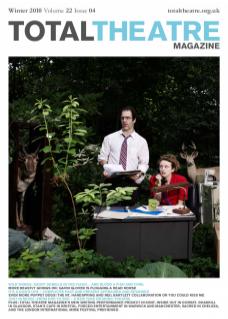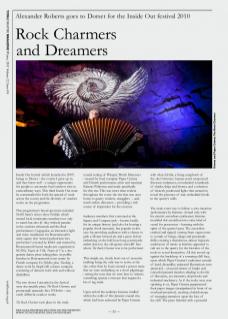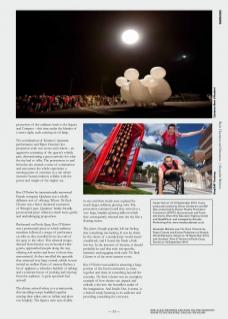Inside Out festival (which launched in 2007) brings to Dorset – the county I grew up in, and thus know well – a unique opportunity for people to encounter local outdoor sites in extraordinary ways. This third Inside Out must be commended for both the spread of work across the county and the diversity of outdoor works on the programme.
This programme’s broad spectrum included NoFit State’s circus show Parklife, which invited local community members not only to watch but also (if they wished) partake in the outdoor rehearsals and the final performance; Congregation, an interactive light and video installation for Bournemouth’s main square that ‘turned pedestrians into performers’ (created by KMA and curated by Bournemouth-based media arts organisation SCAN); Trajets de Ville, Trajets de Vie, a site-generic dance piece taking place on public benches in Bournemouth town centre by French company Ex Nihilo; plus Tracking, a dance work by StopGAP, a dance company consisting of dancers both with and without disabilities.
The two shows I attended at the festival were site-specific piece The Rock Charmer, and promenade spectacle Reve D’Herbert – two vastly different outdoor works.
The Rock Charmer took place in the rural, coastal setting of Winspit, Worth Matravers – created by local company Paper Cinema and Finnish performance artist and musician Kimmo Pohjonen and made specifically for this site. This was more than evident throughout the event: the site that was once home to quarry workers, smugglers – and, much earlier, dinosaurs – providing a rich source of inspiration for the creators.
Audience members first convened at the Square and Compass pub – known locally for its unique history (and also for hosting a popular fossil museum), but popular in this case for providing audiences with a chance to grab a Dorset brewed ale and a pasty before embarking on the half-hour long countryside amble down to the old quarry and cliff face where The Rock Charmer was to be performed.
This simple act, clearly born out of necessity (walking being the only way to arrive at the site, other than by boat) created a potent sense that we were embarking on a short pilgrimage – setting the tone that we were here to witness something special; a treasure that required a bit of leg-work.
Upon arrival the audience became cradled within the walls of this Jurassic coastal site, which had been animated by Paper Cinema with what felt like a living scrapbook of the site’s histories: human-sized scrap-metal dinosaur sculptures; an industrial soundtrack of clunks, drips and drones; and a selection of choicely positioned lights that seemed to reveal the presence of real, embedded fossils in the quarry’s walls.
The main event was to follow: a solo-musician performance by Kimmo. Armed only with his electric accordion-synthesiser, Kimmo moulded this accordion into some kind of vessel for possession – bursting with the spirit of the quarry’s past. The accordion crashed and ripped, veering from organ notes to sounds of bangs, clangs and pneumatic drills; creating a thunderous, almost hypnotic underscore of music as Kimmo appeared to call out to the quarry for the histories of the rocks to reveal themselves. All this served up against the backdrop of a towering cliff face, upon which Paper Cinema’s exuberant cascade of lucid, dreamlike, animated illustrations were projected – a layered cluster of bright and colourful painted sketches alluding to the life of dinosaurs, sea-monsters, shipwrecks and industrial machinery. As if the rocks were now speaking to us, Paper Cinema puppeteered their paper images (manipulated in front of an overhead projector), creating a kaleidoscope of emerging narratives upon the face of the cliff. The piece finished with a peaceful procession of the audience back to the Square and Compass – this time under the blanket of a starry night, each carrying an oil lamp.
The combination of Kimmo’s shamanic performance and Paper Cinema’s live projection work was severe and violent – an aggressive conjuring of the quarry’s volatile past, demonstrating a great curiosity for what the site had to offer. The processions to and from the site created a sense of communion and encounter; the whole experience a meeting point of extremes in a site where intensive human industry collides with the power and weight of the mighty sea.
Reve D’Herbert by internationally-renowned French company Quidams was a wholly different sort of offering. Where The Rock Charmer was a fierce theatrical excavation of Winspit’s past, Quidams’ family-friendly processional piece offered a much more gentle and unchallenging proposition.
Performed on Poole Quay, Reve D’Herbert was a promenade piece in which audience members followed a troupe of performers on stilts as they travelled from one end of the quay to the other. This ethereal troupe, dressed from head-to-toe in hooded white gowns, approached people along the way, offering soft smiles and bows to those they encountered. As they travelled the quayside they attracted very large crowds, which in turn invited an endless flurry of camera-flashes; a lot of applause; a relentless hubbub of talking; and a constant furore of pushing and shoving from the audience. A great spectacle had arrived!
The climax arrived when, at a certain point, this travelling troupe huddled together causing their white suits to inflate and glow very brightly. The figures were now double in size and their heads were replaced by much larger, inflated, glowing orbs. The procession continued until they arrived at a very large, brightly glowing balloon which they consequently released into the sky like a floating moon.
The piece, though popular, left me feeling that something was lacking. It was let down by the choice of a nondescript ‘world music’ soundtrack, and I found the finale a little low-key. In the interests of honesty, it should probably be said that truly site-specific, intensive and engaging work such The Rock Charmer is of far more interest to me.
Reve D’Herbert succeeded in attracting a large portion of the local community to come together and share in something beyond the everyday. The Rock Charmer was an exemplary example of how theatre can unpack and unleash a site into the boundless realm of the imagination. And Inside Out, it seems, is a festival wisely listening to its audience and providing something for everyone.
Inside Out ran 10-19 September 2010. It was produced/curated by Simon Chatterton and Bill Gee; presented by Dorset Theatre Promoters’ Consortium (DTPC), Bournemouth and Poole arts teams, Wave Arts Education Agency (wave) and DepARTure; and managed by Activate Performing Arts. www.insideoutdorset.co.uk
Alexander Roberts saw The Rock Charmer by Paper Cinema and Kimmo Pohjohnen at Winspit, Worth Matravers, Dorset on 16 September 2010, and Quidams’ Reve D’Herbert at Poole Quay, Dorset on 18 September 2010.


